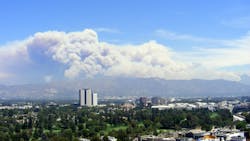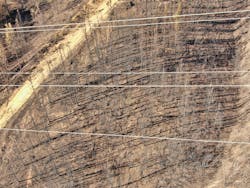When thinking about wildfire risk, New England is probably not the first region that comes to mind. These events are more closely associated with the arid, mountainous West. However, that does not mean other parts of the map — and the utilities that operate within them — are free of risk.
Drought conditions seized large chunks of the U.S. Northeast in the closing months of 2024. Swaths of New Jersey and Massachusetts experienced what the U.S. Drought Monitor classified as severe or extreme drought conditions. The same was true in West Virginia and Ohio. Unsurprisingly, this translated into above-normal levels of significant wildland fire potential. Late-year fires in New York, New Jersey, Massachusetts and Connecticut claimed more than 8000 acres.
Farther south, a pair of wildfires burned more than 400 acres in North Carolina in January 2025. Local officials claim that one of them — the McDowell County Crooked Creek fire — was sparked after a tree fell on a power line. Downed trees and debris from Hurricane Helene helped to fuel both blazes. In December 2024, a 10-acre brush fire threatened residences around Chattanooga, Tennessee. Eight years earlier, a series of wildfires devoured more than 80,000 acres across North Carolina, northern Georgia and eastern Tennessee. Regional drought conditions at the time were within the U.S. Drought Monitor’s extreme and exceptional range.
By the numbers, these figures are far below the acreage that wildfires burn in places like California, Idaho and New Mexico. In these places, wildland flames regularly claim hundreds of thousands of acres per year. Yet, this kind of comparison is not nearly as straightforward as it might seem. Even California, the most populous state in the Western U.S., has far fewer people per square mile than densely populated states like Massachusetts and New Jersey. It is also worth noting that outside the wide-open spaces of the West, human-built infrastructure is not only everywhere but also typically much older.
For the rest of the U.S., the risk of conflagration is there. It has happened before and will happen again. With researchers projecting increased risk for precipitation shortfalls, swelling fuel stocks and elevated fire conditions in coming years, the potential threat to life and property is difficult to ignore. Utilities from coast to coast and everywhere in between must be prepared.
Strategic Planning
As western utilities have learned through hard experience, successful wildfire mitigation means replacing reactive responses to crisis with proactive plans. They aim to stop fires from sparking and manage and minimize their impacts when they do.
While reactive measures (for example, developing storm response plans) can help to swiftly repair damage and restore service, they do little to manage the risk of either starting a fire or making one worse. On the other hand, proactive planning entails diligently scrutinizing risk and carefully allocating resources in ways that reduce it.
Developing a fire potential index (FPI) is a crucial first step in supporting strategic planning and real-time decision-making. As a composite metric incorporating factors like fuel abundance, precipitation, wind speed and human activity, the FPI is part of a suite of tools for grid operators to assess and quantify fire risk across specific sections of the grid. Its resolution is constrained only by the availability of localized data on these key parameters.
A robust data model and complete, accurate data are needed to support the calculation of an FPI. In turn, this metric can be used as a basis for confident decision-making at the strategic (for example, executive leadership and long-term planning) and tactical (such as real-time operations and frontline response) levels.
With an FPI, quantitative models replace guesswork with real statistical risk assessment. As a result, utility leaders and control room operators can be more confident the decisions they make ahead of, during and after a fire risk or fire event are the right responses to the right data.
Public Safety Power Shutoffs
A public safety power shutoff (PSPS) event provides an excellent illustration of strategic and tactical decision-making as informed by an FPI. To visualize how an FPI might inform decision-making from a strategic perspective, consider the following questions:
- When is the risk present?
- Where physically is the risk in relation to real assets?
- What does end of life look like for the assets in at-risk areas? That is, how prone to ignition risk are the assets?
- When was the last time the assets were inspected?
- When should customers lose their ability to power their homes and businesses?
- How does ignition risk vary across asset types, vegetation clearances, and prior fault data?
Answers to these key questions help to create tangible thresholds for when PSPS events will affect a utility’s customer base. Because the decision to institute a PSPS is anchored in data rather than assumptions, the utility’s response will be repeatable and predictable — both for their customer base and their regulators.
From a more near-term, tactical perspective, the FPI can inform the duration and extent of the PSPS event. Those strategically predetermined thresholds set useful boundaries for tactical, in-the-moment decision-making. Consider the following:
- What is the utility’s ability to isolate risk while keeping customers in service?
- When is the risk of creating new fires at an acceptable threshold for restoring customers’ access to power?
- What is the utility’s ability to prepare prewritten switching plans?
There are certainly more questions utilities must begin to ask themselves regarding how an FPI should be integrated into their wildfire response plans. Questions like these can help to clarify how this tool and approach differs from traditional storm response plans.
Robust wildfire mitigation strategies depend on having the right tools and processes in place before a destructive blaze even starts. A storm response plan, on the other hand, effectively begins after the storm has passed.
Plan for the Worst
Children and people who work in dangerous professions are taught to stop, drop and roll if their clothes catch fire. This basic fire safety technique is taught for a simple reason: People need to know what to do if they are in a life-threatening fire emergency before the emergency happens.
Many utilities across the U.S. identify as public service utilities. Public service carries with it an implicit responsibility: to not be responsible for one of the worst events in their customers’ lives.
To exemplify that ethos, utilities both plan for and react swiftly and effectively to wildfire threats. They put well-informed strategic and tactical decision tools and protocols in place before their assets spark a fire or are threatened by one.
Utilities own and operate complex, tightly interlinked systems on which the whole of modern society depends to perform even the most basic functions. A single bad decision has the potential to cause devastating consequences, effectively becoming the worst thing that ever happened to a community.
This is a reality everywhere. Even in areas where wildfires rarely dominate headlines, diligent planning based on robust, verifiable data is an essential step to guard against devastating worst-case scenarios.
Utilities that develop a robust and comprehensive understanding of how fire risk is distributed across their assets position themselves to respond intelligently, effectively and predictably to crisis conditions. Predictability is critically important here. Defined decision matrices that govern when to deenergize or reenergize assets not only benefit ratepayers but aid municipal first response and help to support other critical infrastructures, as well.
Western utilities are already deeply familiar with the challenges inherent in effective wildfire mitigation. They know what it takes to plan and prepare for the worst. But these concerns are not isolated to any specific patch of geography.
With drought conditions on the rise and potential fuel loads increasing, utilities from coast to coast can benefit from examining their risks and developing effective strategies and tactics to address them. By crafting predictable response plans rooted in real-world data and preparing to tackle fire emergencies long before they hit, public service utilities can continue to deliver the same reliable public service to their communities they have provided all along.
About the Author
Josh Tweedy
Josh Tweedy is a seasoned utility operations leader with over 20 years of experience in system operations and grid modernization. His expertise centers on utility-scale wildfire preparedness, response and recovery, having directed multistate wildfire mitigation efforts, public safety power shutoffs and incident management procedures. As a director of operations at major utilities across the U.S., he has led cross-functional teams in developing and executing comprehensive wildfire response strategies, integrating advanced tools like meteorology tools and data integration; Power BI dashboards; advanced distribution management, distribution management and energy management systems; Maximo/SAP; and Palantir to enhance decision-making and operational visibility.


